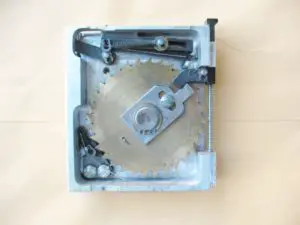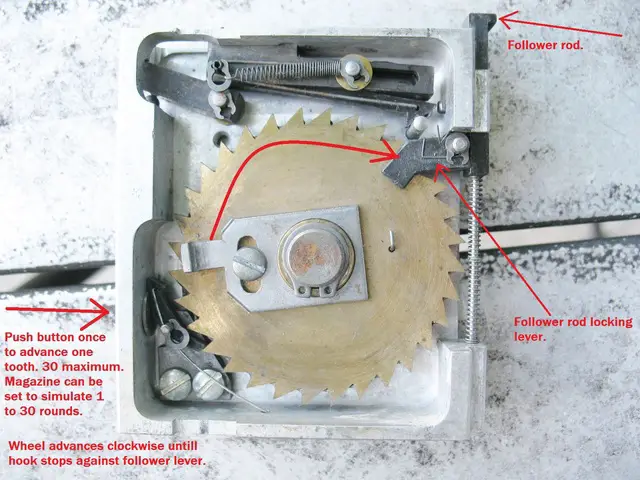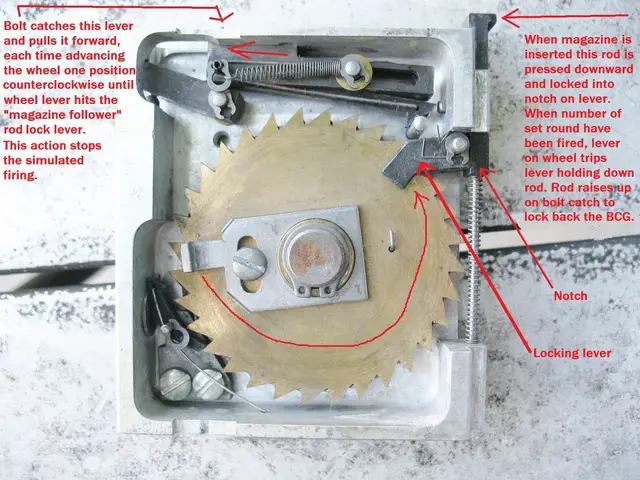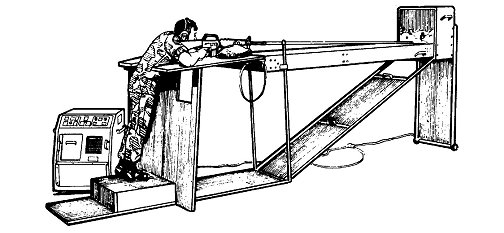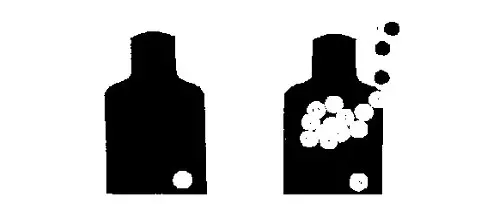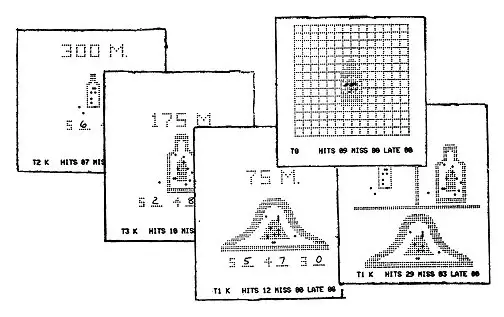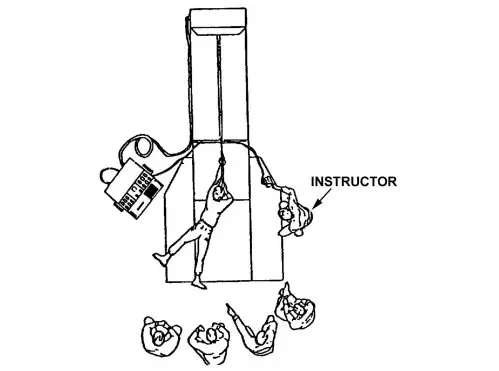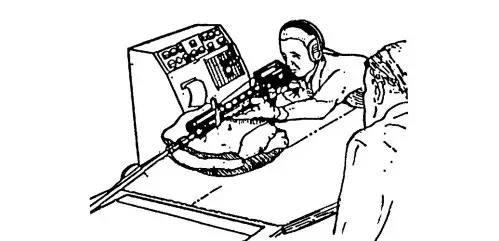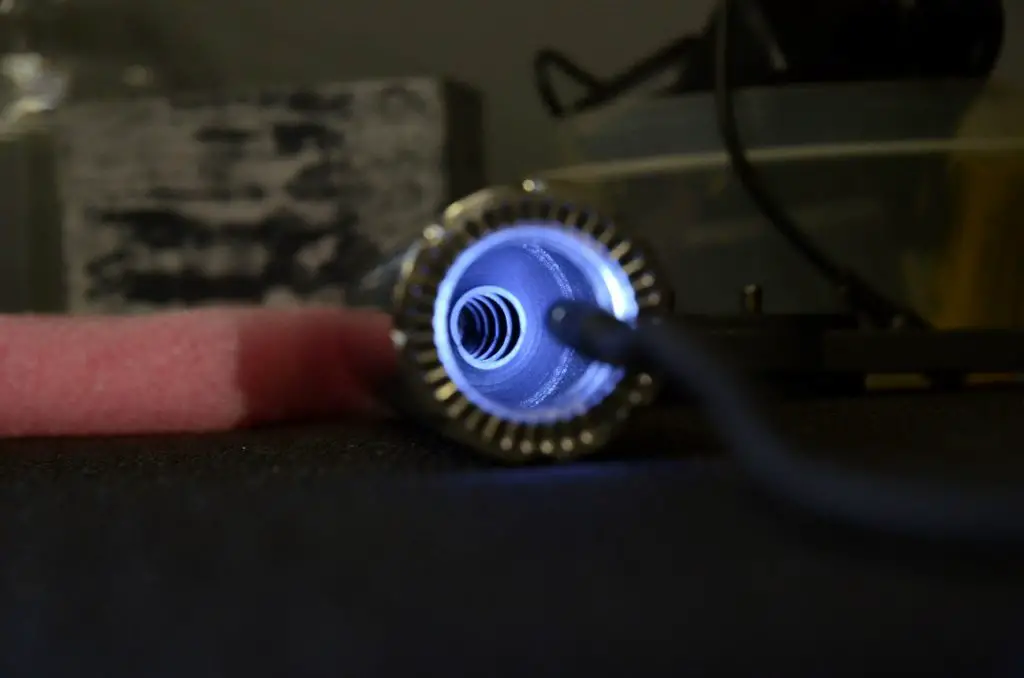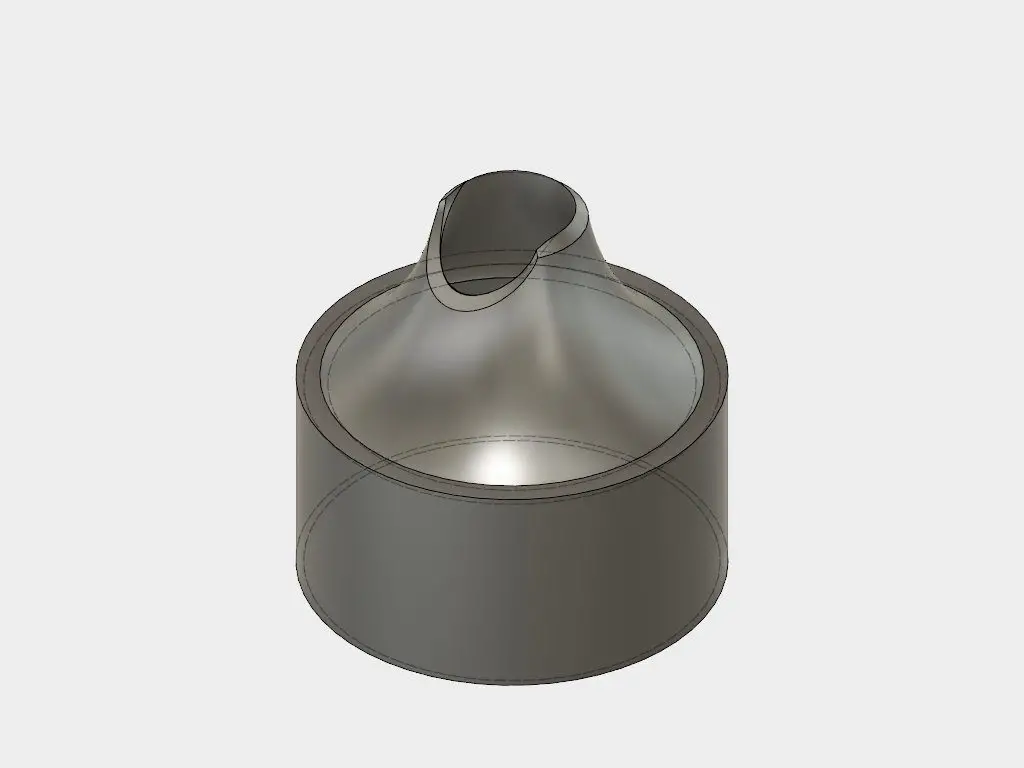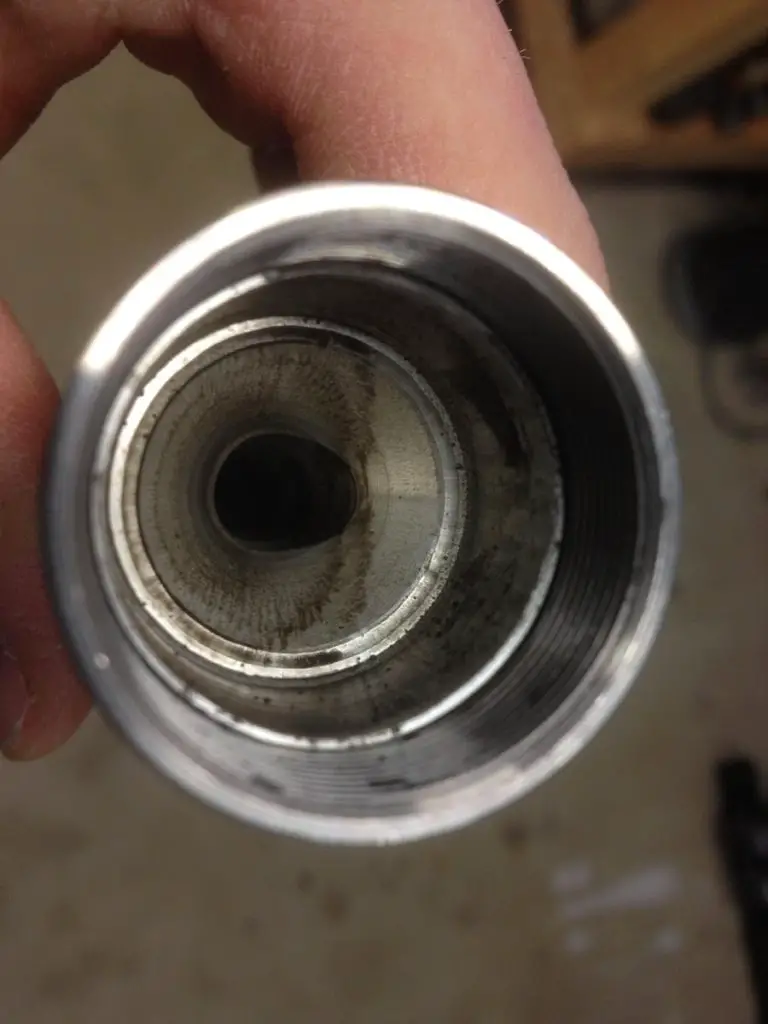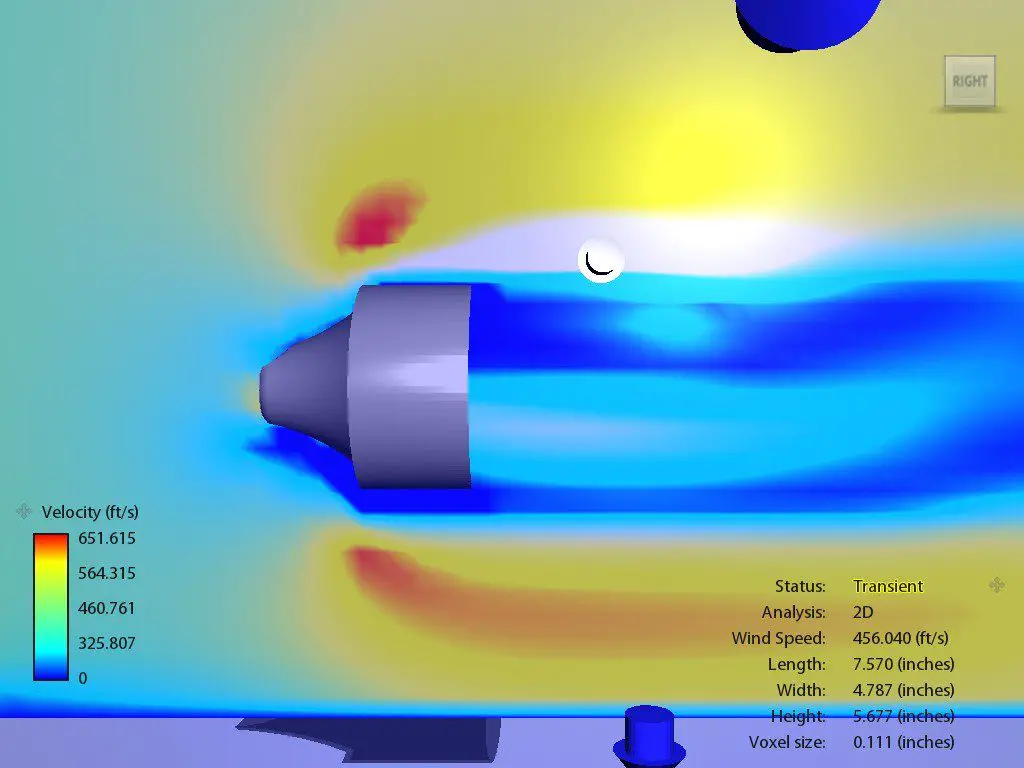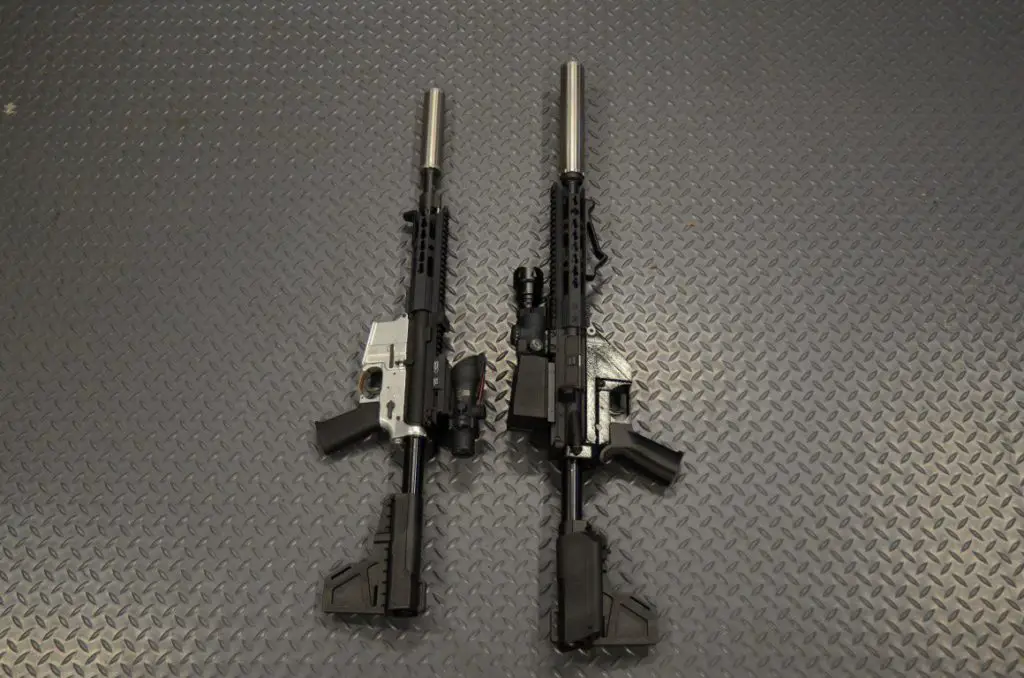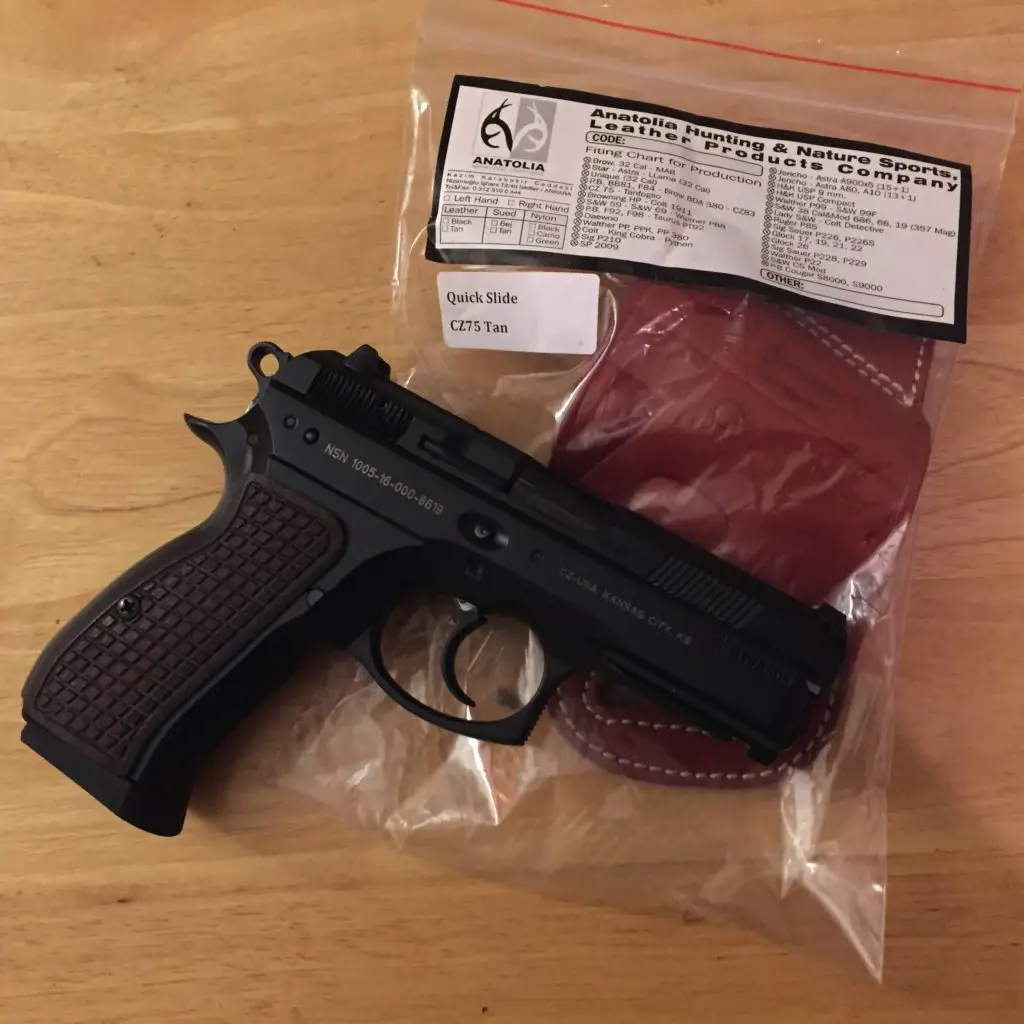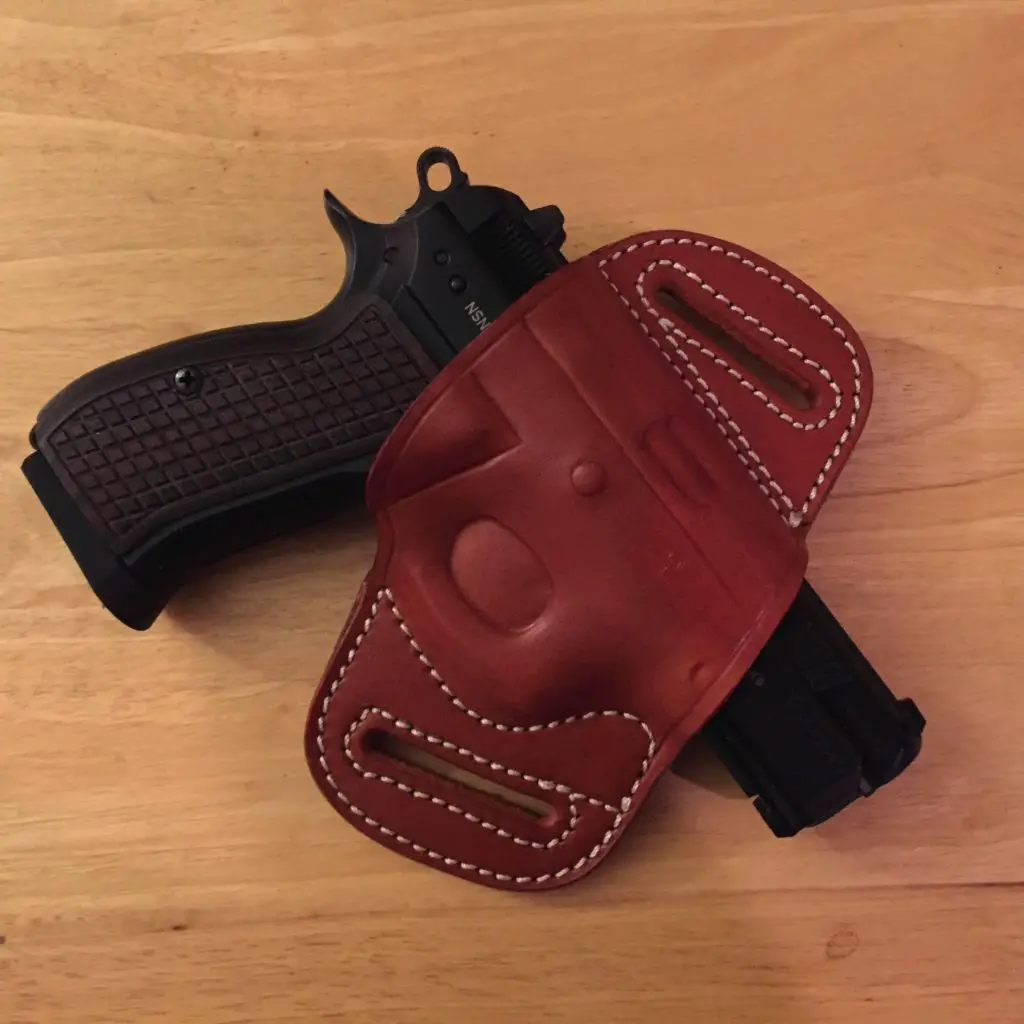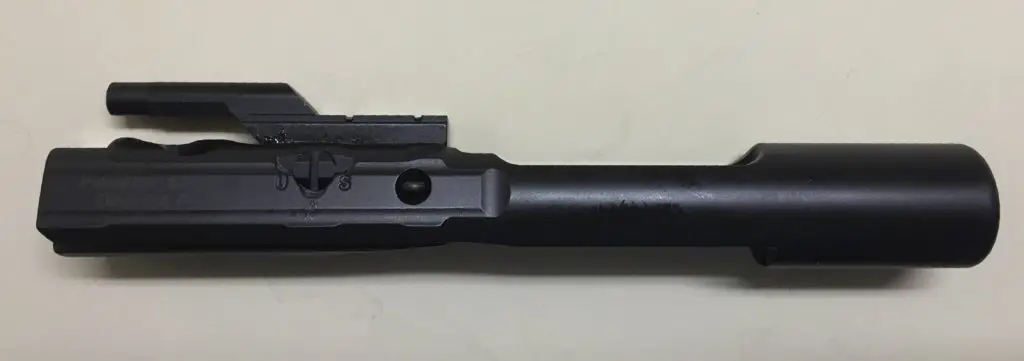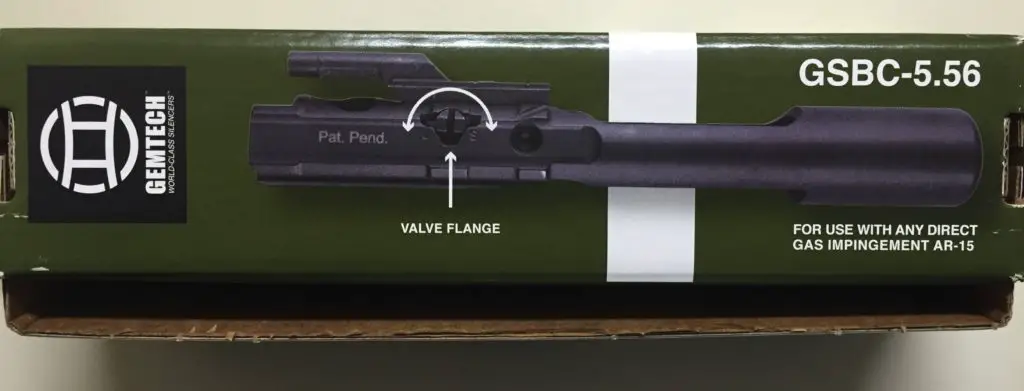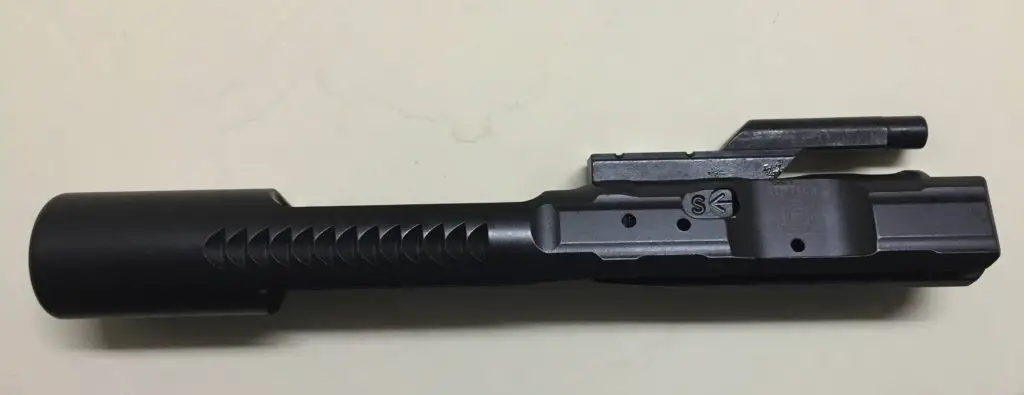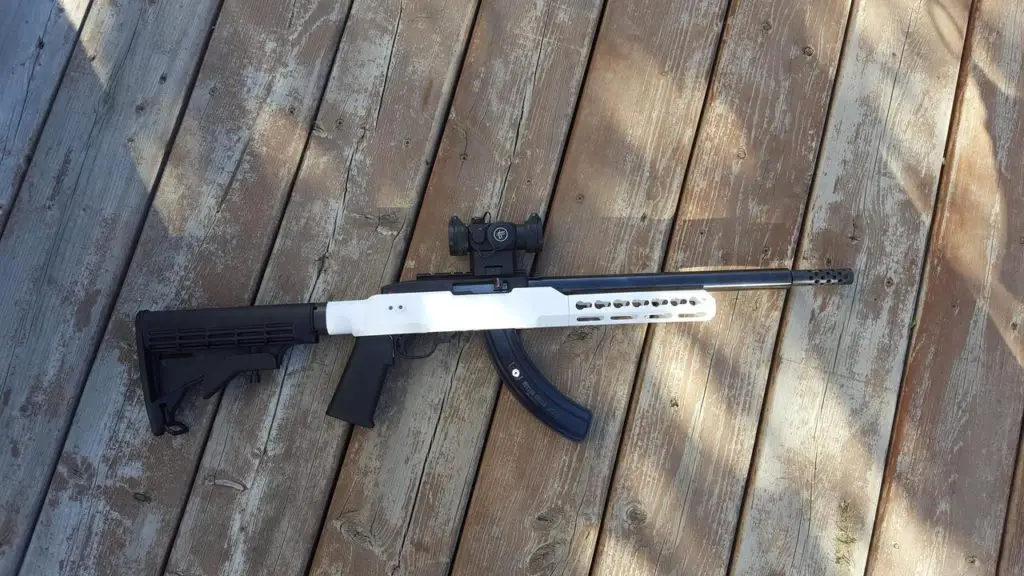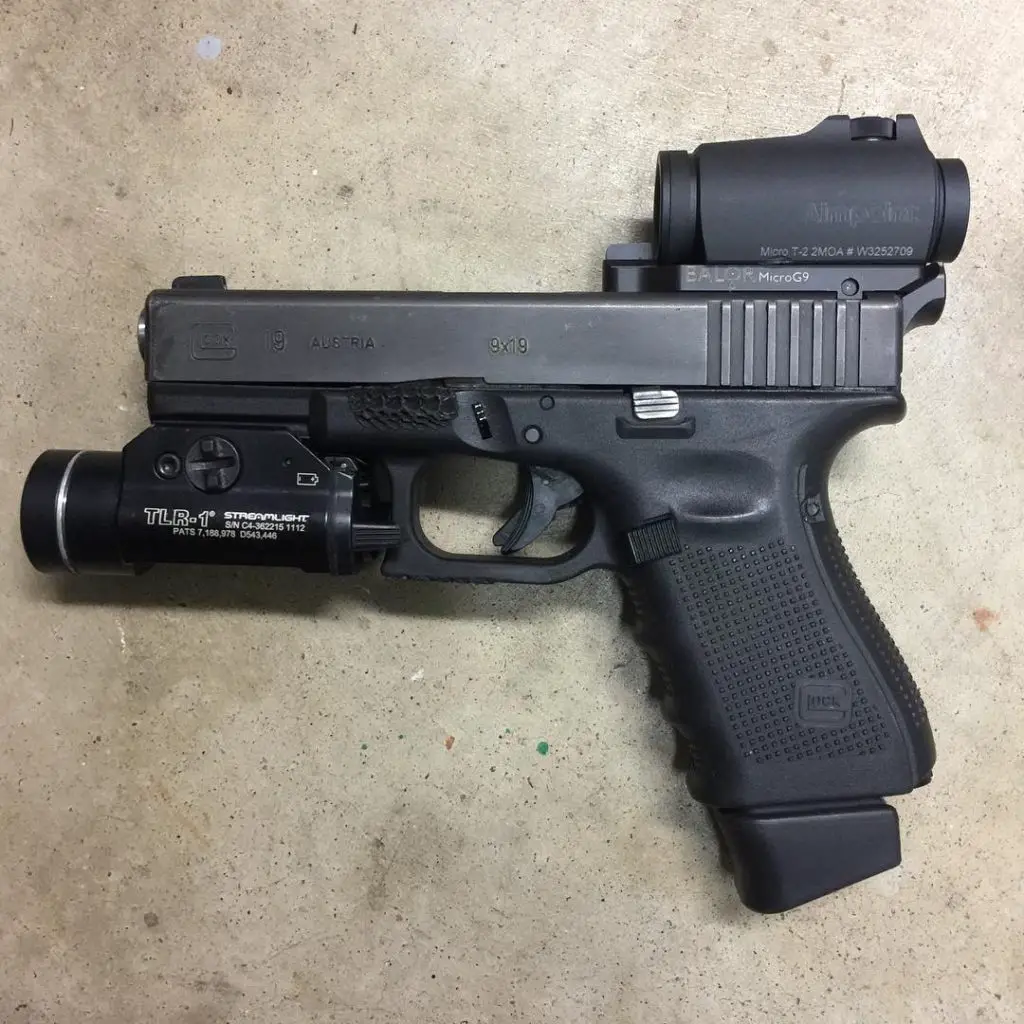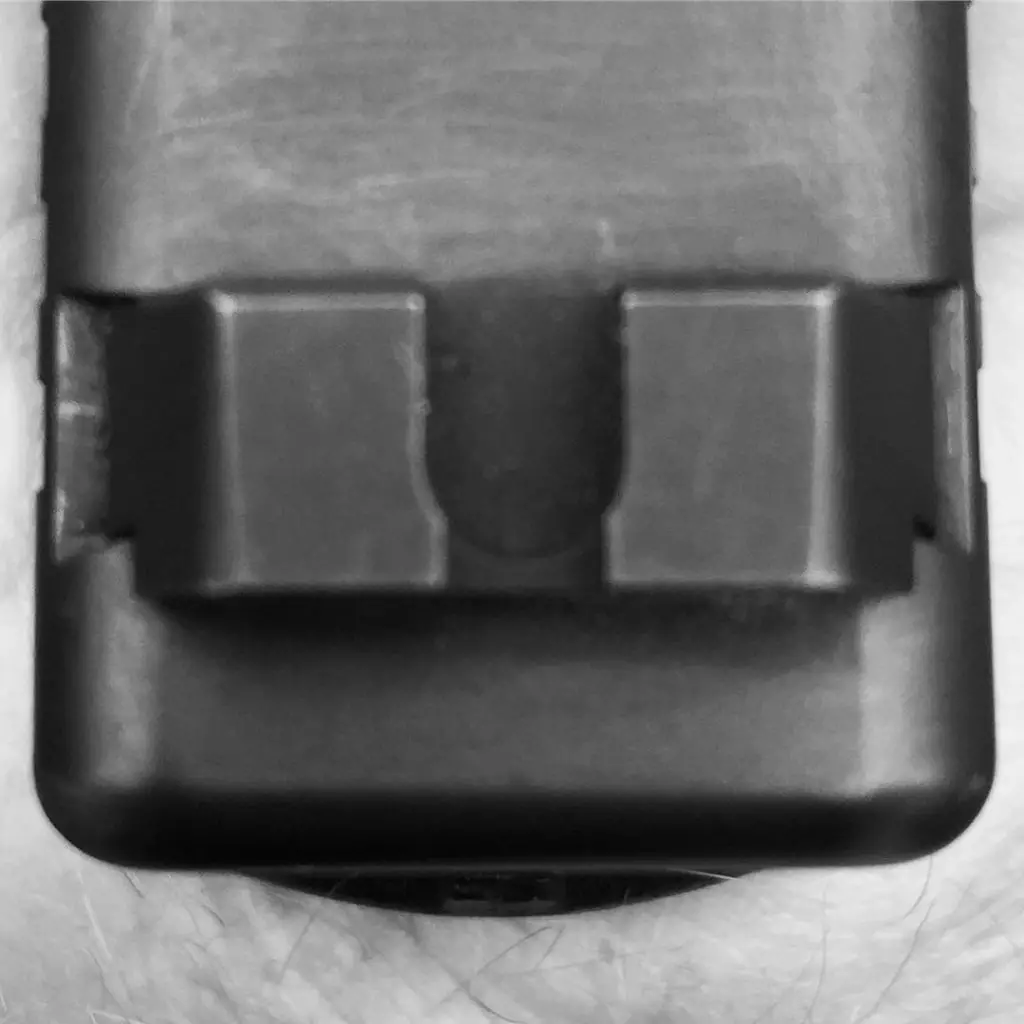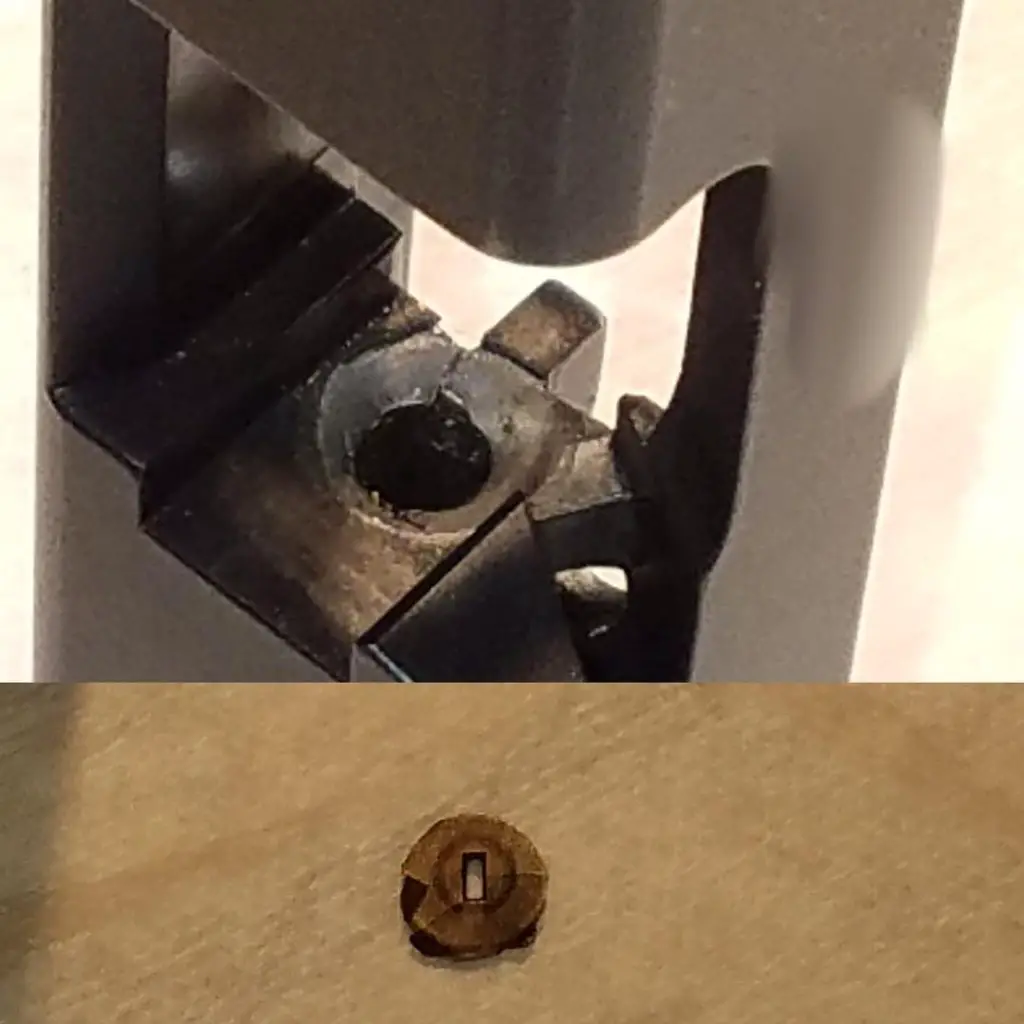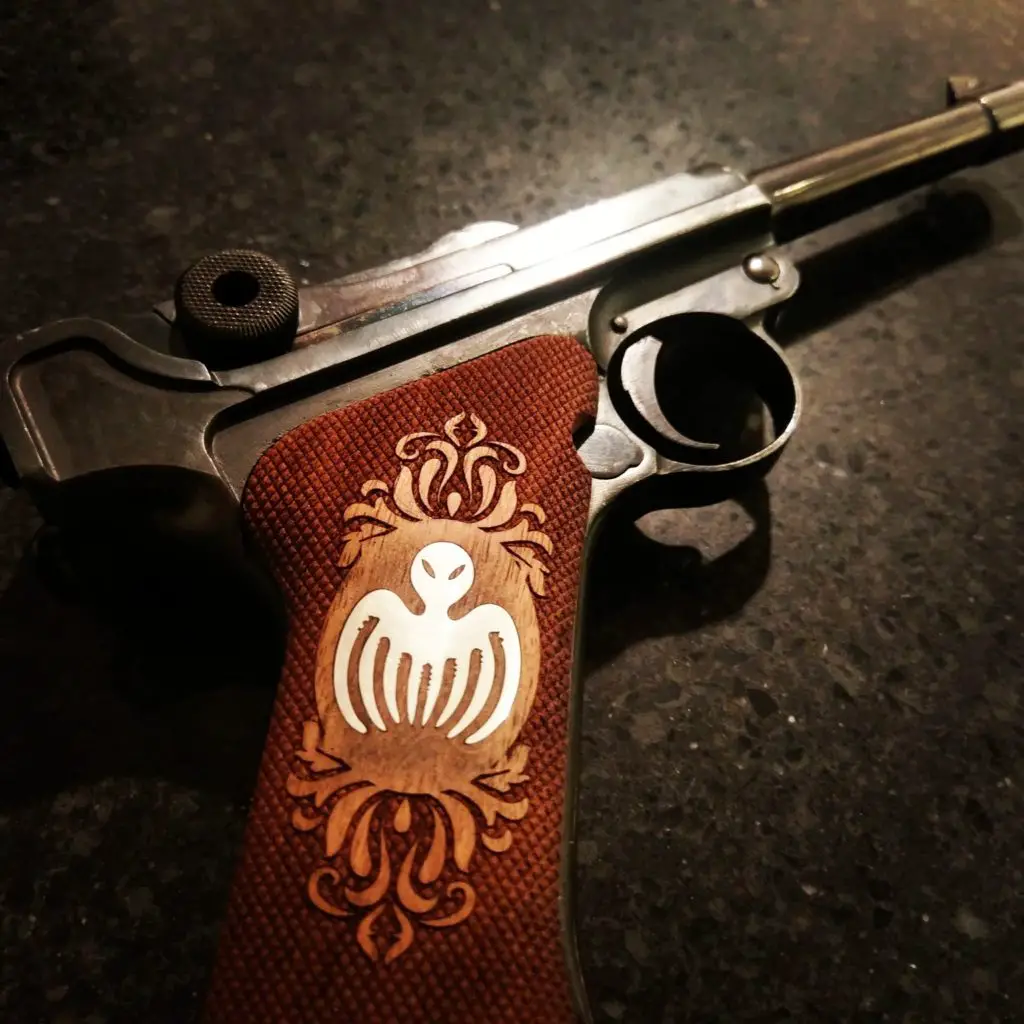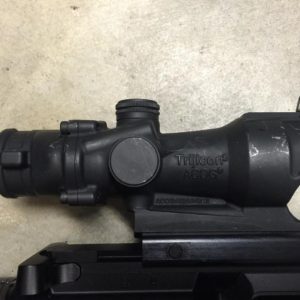Simulators have always been the Next Big Thing ever since Ed Link conned the Army Air Corps into believing that they could teach instrument flying on the ground. (After a series of planes came tumbling out of overcasts in pieces, the ferry command that was in charge of delivering aircraft and crews to Great Britain for the World War stopped trusting pilots with an Air Corps instrument card, and started retraining them). As the ferry command found, a simulator could be a good adjunct for live training, but it was a poor substitute.
In the 1970s, the Army followed the siren song of simulation and developed a training device called the Weaponeer. The dream was: rifle training without rifles. Or ammunition, or ranges; and it worked, to a degree — like that 1940 Link simulator. Weaponeer was a very robust arcade game built around a modified rifle (then, an M16A1) that tried to simulate the experience of firing a rifle. It actually “kicked” with a fairly accurate recoil. It also simulated the accuracy of the weapon pretty well, its cycling, and even magazine changes with bolt lockback on an empty mag. The gadget shown above was inserted in a modified magazine shell and could be “loaded” with zero to thirty “rounds.”
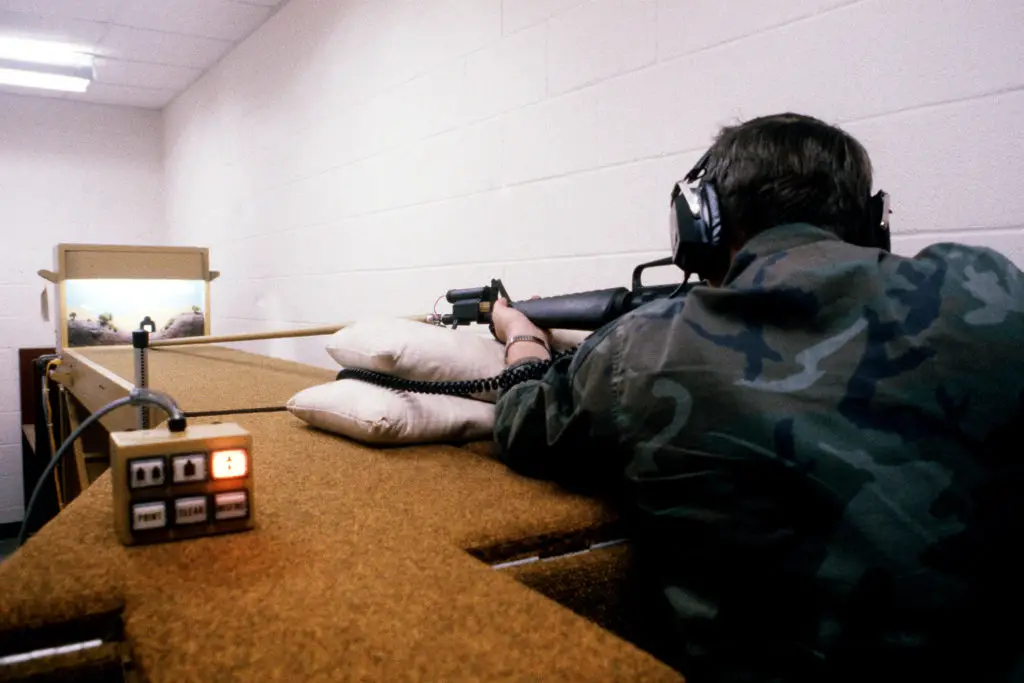
A soldier uses the Weaponeer marksmanship training system. US Army photo from Fort Devens, MA, 1990.
Weaponeer was invented and initially debugged by 1973, and widely adopted and fielded in the Army by the early and mid 1980s. In some places it worked well (for instance, as a mechanism for instructors to observe green trainees that were struggling with basic rifle marksmanship, and break them of bad habits, or for members of an element that needed to maintain proficiency in a non-permissive overseas environment in which they could not go to military ranges). In other situations it did not work as well. Some service support units, never fond of going out to messy rifle ranges, used it to “qualify” in shirtsleeve conditions.
It was not extensively exported. These Kuwaitis being trained by an American sergeant are among the few foreigners to have used the system.
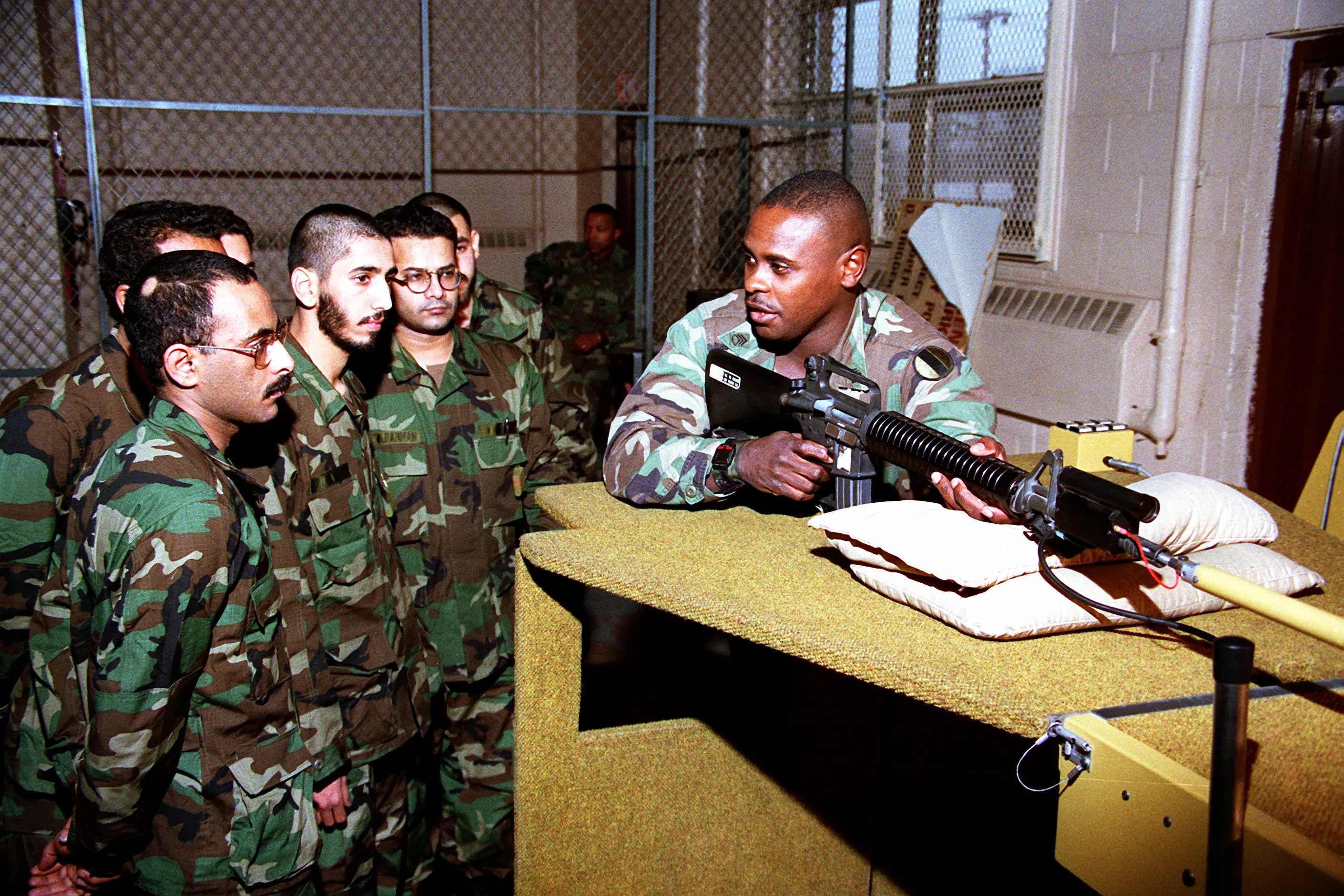
An instructor explains the Weaponeer Marksmanship Training System to Kuwaiti soldiers during a marksmanship course. The soldiers are being trained in combat techniques in preparation for conflict with Iraqi forces presently occupying Kuwait. Fort Dix, NJ: 8 Jan 91 via the National Archives.
In any event, the artifact at the top of the post turned up recently, and with it being vaguely M16-magazine sized and shaped, its new owner turned to the ARFCOM Retro Forum for answers. He got them, including these detailed pictures that explain how the magazine insert works. Read The Whole Thread™, which also has more pictures.
An appendix to the marksmanship training manual (Appendix A-6 to FM 3-22.9) gives more information.
The Weaponeer is an effective rifle marksmanship-training device that simulates the live firing of the M16-series rifle. The system can be used for developing and sustaining marksmanship skills, diagnosing and correcting problems, and assessing basic skills.
Characteristics. The Weaponeer operates on 110 to 130 volts AC, 10 amperes, 50 or 60 Hz, grounded electrical power. (A stand-alone voltage transformer is provided for overseas units.) The recommended training area for the Weaponeer is 10 by 23 by 8 feet. The operational temperature range is 40 degrees to 100 degrees Fahrenheit. The Weaponeer must be protected from the elements, and should not be subjected to excessive vibration, high dust levels, or condensing humidity. The M16A1/A2 attached to the Weaponeer is demilitarized and does not require the usual weapon security.
The rifle, with the exception of smoke and cartridge ejection, operates normally, and has the same weight and balance as the standard weapon. An infrared aiming sensor simulates round trajectory and hit point to an accuracy of better than one-minute-of-angle. The recoil rod that attaches at the muzzle end of the rifle simulates recoil. Recoil is provided in both semiautomatic and automatic modes of fire, and is adjustable from no-net force to 30 percent more than that of a live M16. Sound is provided through headphones and is adjustable from 115 to 135 decibels. Special magazines are used. One magazine simulates a continuous load; the other (used to train rapid magazine change) can be loaded with 1 to 30 simulated rounds. Selectable misfire can be used to detect gun shyness and drill immediate action. The front and rear sights are zeroed the same as standard rifles.
As you can see, that describes the magazine insert that the ARFCOM member got hold of.
The Weaponeer range can be raised or lowered to accommodate all firing positions. The target assembly contains four targets: a scaled 25-meter zero target and three pop-up targets are standard. E-type and F-type silhouettes at ranges from 75 meters can be used on the Weaponeer. Known-distance and various other types of targets can be used and be displayed in fixed or random sequences. Target exposure times may be set to unlimited or from 1 to 30 seconds. The fall-when-hit mode can be selected with the KILL button.
The operator’s console contains the system control buttons, graphics printer, and video feedback monitor. The back of the console has counters that total rounds and hours, and a storage bin for storing magazines, printer paper and ribbon, headphones, two wrenches for assembling the Weaponeer, and a small allen wrench for aligning the rifle sensor. A remote control, which attaches to the back of the console, enables a trainer or firer to operate select functions away from the console.
Feedback. The Weaponeer provides feedback to help trainers to teach and soldiers to learn marksmanship skills.
- Fall-When-Hit Mode. Lighting the KILL button enables the fall-when-hit mode. When the button is activated, targets fall when hit. This feedback provides the same hit or miss information as a train-fire (RETS) range.
- Real-Time Aiming Point Display. When a firer aims on or near a target, his aiming point relative to the target is continuously displayed on the video screen. The aiming point display allows the trainer to teach and verify aiming techniques, and to continuously monitor the firer’s steadiness, techniques, time on target, trigger squeeze, and recovery from recoil.
- Immediate-Shot-Impact Display. When a shot is fired, its impact relative to the target is immediately displayed on the video screen as a blinking white dot (Figure A-12, left target).
- Replay. After a shot is fired, a real-rate display of how the firer engaged the target can be replayed on the video screen.
- The target to the right in Figure A-12 shows the type of information that can be replayed on the video screen after a series of shots are fired. To show the sequence, the dots have been numbered.
- To show a replay, the firer first selects the shot he wishes to replay by operating the EACH SHOT button. Then he presses the REPLAY button. Some Weaponeers record and store replays for just the first three shots.
- Shot Groups. The impact location of up to 32 shots is automatically stored in the Weaponeer memory and displayed on the video screen. Each impact is indicated by a white dot, which blinks when indicating the last shot. All 32 shots can be fired and displayed on a single target, or split among a combination of targets. The CLEAR button erases all shots from the Weaponeer memory
- Printer. A hard-copy printer is provided for postfiring analysis, for firer progress tracking, and for record keeping. Pressing the PRINT button causes the target displayed on the video to print. (Sample printouts are shown in Figure A-13.) Some Weaponeers can print the three pop-up targets at the same time by holding in the REPLAY button and pressing the PRINT button.
Use of the Weaponeer. In BRM, the Weaponeer is used to evaluate the firer’s ability to apply the four fundamentals. It is used throughout the program to help diagnose and remediate problems. In the unit, the Weaponeer should be used much like it is used in BRM. Concurrent use of the Weaponeer at the rifle range provides valuable remedial training.
- The preferred training configuration for the Weaponeer is shown in Figure A-14. One trainer operates the system while three to six soldiers observe the training. Soldiers should rotate, each receiving several short turns on the system. Where high throughput is required, consolidation of available Weaponeers may be considered.
- When training soldiers on the Weaponeer:
- Proceed at a relaxed pace, and emphasize accuracy before speed.
- If possible, train with small groups, allowing each soldier several 10- to 15-minute turns on the device.
- For remedial training, try to relax the soldier. A nervous soldier will have trouble learning and gaining confidence in his marksmanship skills. For sustainment training, encourage competition between individuals or units.
- In Figure A-14, five soldiers are being trained. One is firing and four are observing, awaiting their turns on the device. The video screen is carefully positioned just outside the vision of the firer, but the firer can easily turn his head to see replays and hit points. The position of the trainer is also important so he can see both the firer and video screen. This is a good position for detecting and correcting firing faults. When the firer is in the standing supported firing position, the console should be placed on a table so the trainer can see the video screen above the firer’s rifle (Figure A-15). Observers can see the targets, firer, and video screen and learn procedures that speed up training and help avoid firing faults.
Unfortunately, the Army does not appear to have released Weaponeer devices as surplus, but has destroyed them instead. It would be a fun thing to have in your man cave, if you could keep it working. For a while in the late 1980s, dozens of these things were dead in units all around the world.
Without a whole Weaponeer, the device the original poster has is of no utility, but it’s an interesting artifact.
Here is some further information on Weaponeer.
- Weaponeer was supposed to be replaced by a system called EST 2000 (which also was intended to replace a buggy computer-based system that ran on a, we are not making this up, Commodore 64).
Guy in a Garage Gets Quiet… in 5.56 and 7.62 (.300 BLK)
(Yes, 80s-90s era SF’ers, the “5.56 and 7.62” is a Blank Frank Toney reference. For the rest of you, on with the story). Our good friend Guy in a Garage (hereafter Guy) has been up to all kinds of good. You may recall that some time ago he applied to the ATF to manufacture suppressors on ATF Form 1.
He didn’t go about it by half measures. Here’s his 5.56mm suppressor, showing 3D design, computer finite element analysis of the projected flows, and parts machined, mostly, from 7075 round bar stock. The tube is Ti alloy. There’s a large chamber, followed by a blast baffle.
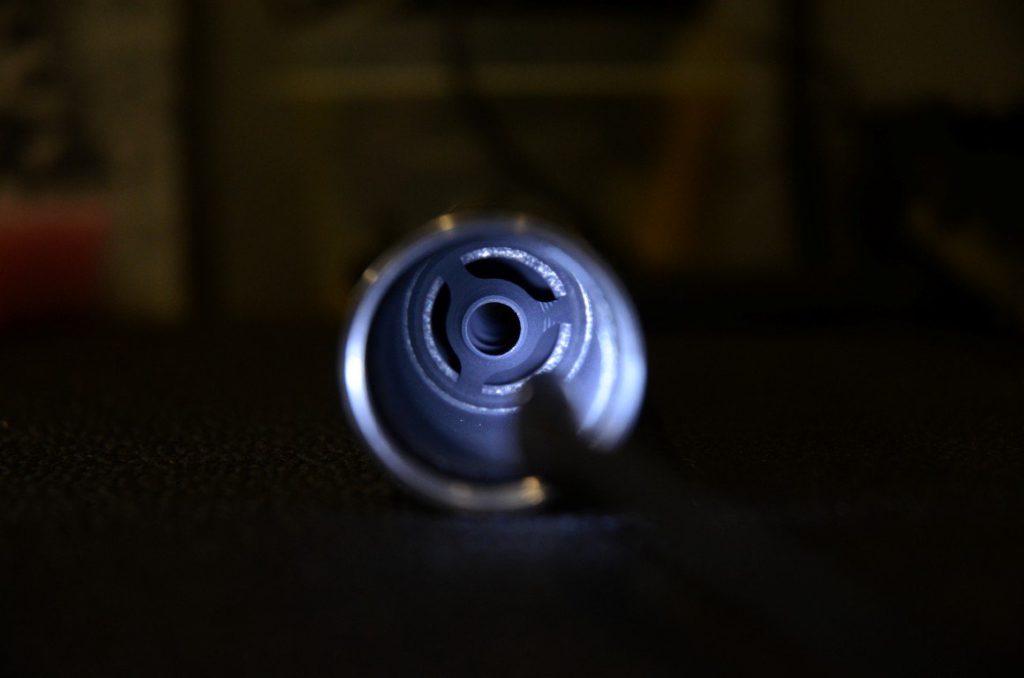 While the baffles are generally made of aluminum, the blast baffle is 416 stainless. Guy says:
While the baffles are generally made of aluminum, the blast baffle is 416 stainless. Guy says:
Here’s the 3D design of the blast baffle: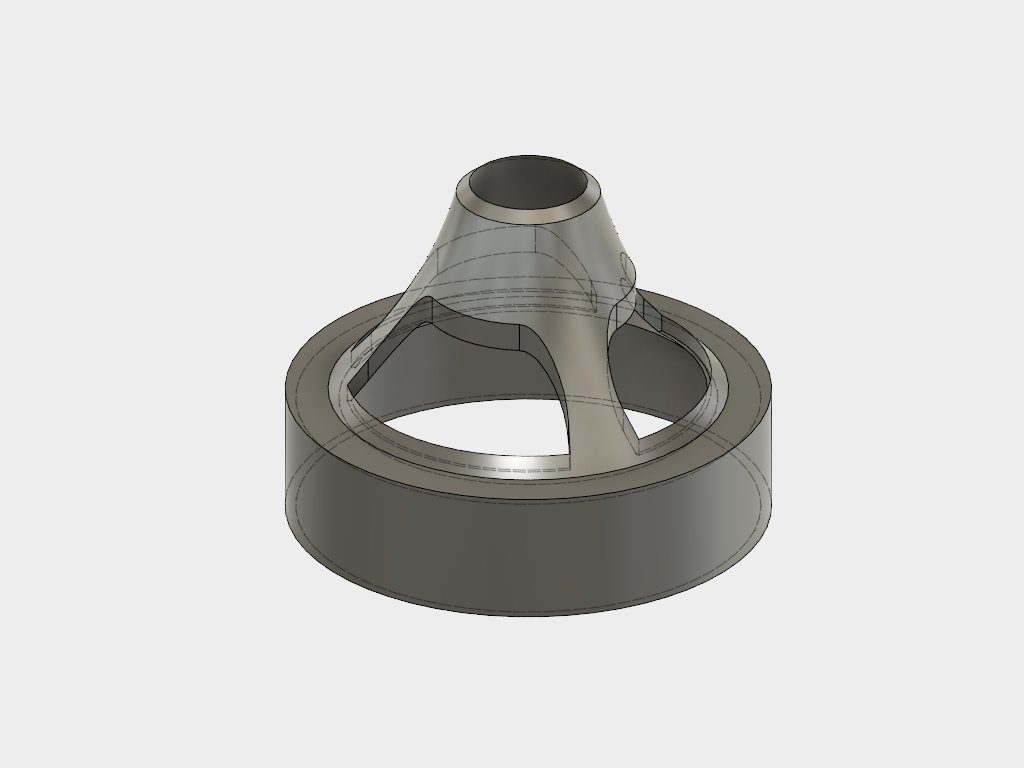
The regular baffles. These are very reminiscent of some baffles Gemtech uses, as discussed below.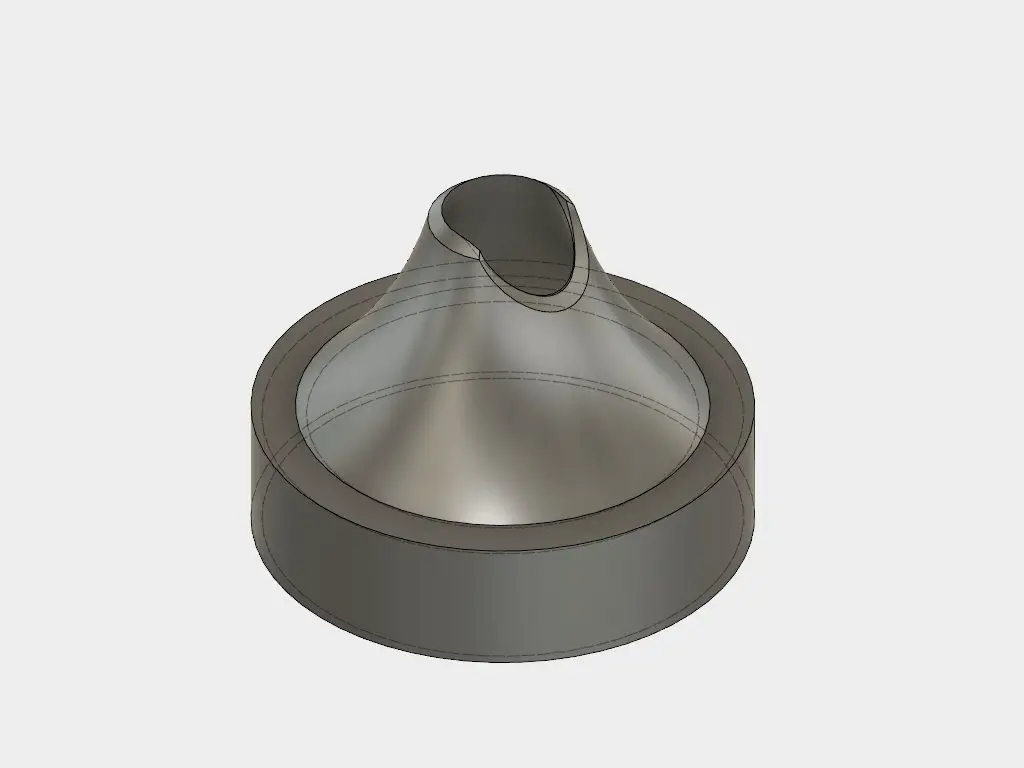 Here’s the FEA of the baffle, showing the projected pressure drop across it. Noise suppression is all about managing pressure, temperature and time. (Software: Autodesk Flow Design, which is free as in beer).
Here’s the FEA of the baffle, showing the projected pressure drop across it. Noise suppression is all about managing pressure, temperature and time. (Software: Autodesk Flow Design, which is free as in beer).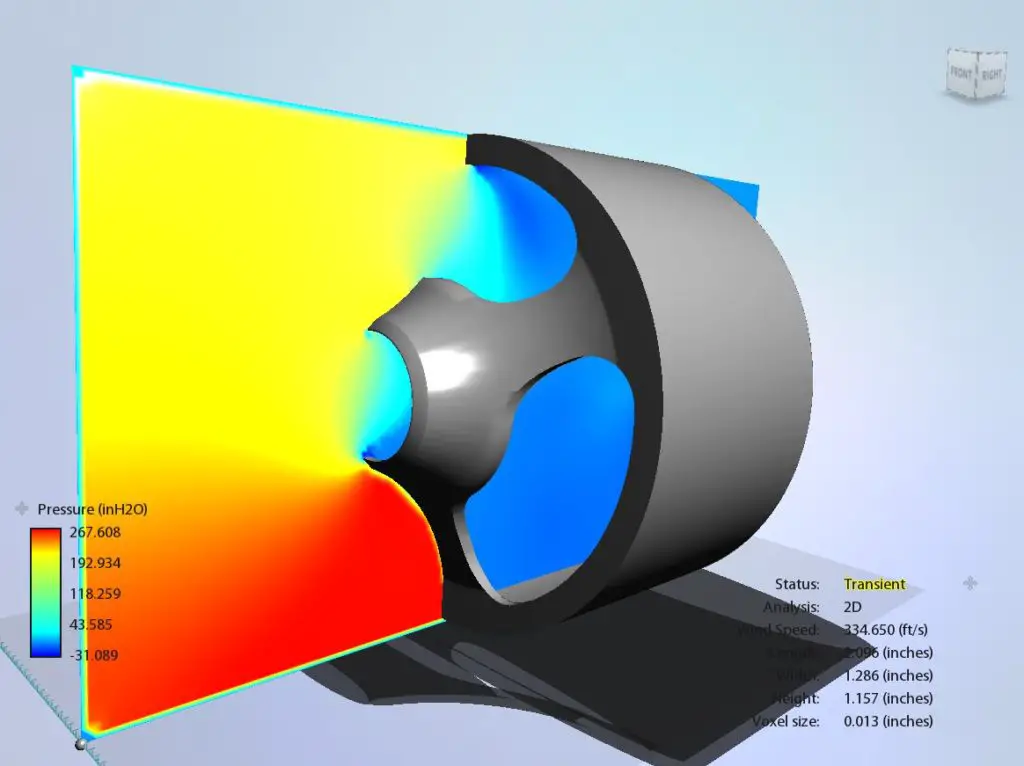
And here’s similar beauty shots of his .300 Blackout suppressor.
A look in at that type of baffle. That’s not a baffle strike, that’s a feature of the design:
And here are the pair of them, completed and installed:
There are some other Guy in a Garage features there, including a home-made lower and home-made thermal sight. He used a quick-detach system designed by Yankee Hill Machine.
A suppressor (or any muzzle device) made of aluminum alloy, even a strong one like 7075, is going to have durability issues relative to one made of steel or exotic material like cobalt alloys (Inconel) or titanium alloys. But the exotic metals are much harder to machine than steel. This is one reason that selective laser sintering has been cost-effective for prototyping and limited production in such exotics. If you’re limited to subtractive manufacturing, aluminum alloys and steels are much more easily cut.
A word on baffles. We just got to try out a Walther .22 with a Gemtech suppressor that uses a similar style baffle. The suppressor was Hollywood tiny, but with subsonic ammo it was graveyard quiet. In fact, close to Hollywood quiet. (You do know the sounds of “suppressed” firearms in movies are dubbed in in post-processing by the Foley artists, right?) It made our old Hi-Standards sound like a 2″ .44 Magnum by comparison. We didn’t try the pistol with supersonic ammo, but the guy who had the Gemtech (his organization’s, we think, not personal) says it’s still extremely quiet, just not that quiet.
In the Gemtech, the little notch that looks to the novice eye like an artifact of a baffle strike — it isn’t — is turned 90º from the one in the preceding baffle. The Gemtech’s baffles are made of titanium, one reason the suppressor is as light as it is small.
Update
We should have initially included these, in which Guy (username Flood_) answers many questions: Imgur thread and Reddit thread, both from three weeks or so ago. Don’t forget to click the “More comments” button at Reddit.
Join a Minority (Pistol) Group
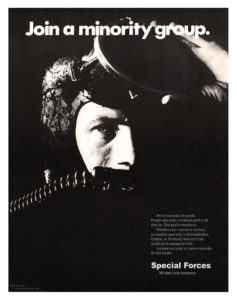 OK, so “It’s Over. And Glock Won,” as we posted a while back. But as we never really warmed up to the G17, we went back to a CZ.
OK, so “It’s Over. And Glock Won,” as we posted a while back. But as we never really warmed up to the G17, we went back to a CZ.
Like we did when we filled out the first of many sheaves of volunteer paperwork, we Joined a Minority Group.
When you join a minority group, you can find yourself, well, not fitting in. You’re different. People look at you funny. You might be feared, shunned, even hated. You tend to band together with people like yourself.
There’s probably something about it in the Bible, or maybe the Book of Mormon (in the Book of John Moses?), that says that the bearers of the 1911 shall cleave to one another, and not suffer the bearers of the unclean European wondernine to pass among them; and the Pharisees of the K-Frame and Python listened not to the gospel of the autopistol, but gathered among themselves and called for the stoning of the autopistoleros, especially those whose frames were cast of polymer, which is unclean.
Well, there’s a certain sense to that. With your only six rounds gone, aren’t fist-sized stones the handiest Plan B?
The cultural Siberia to which the odd-brand pistol-packer exiles himself is not the whole problem, or even the largest part. More practically, changing pistols is a royal pain in the part where Glock operators occasionally puncture themselves. If the pistol were the be-all and end-all of your self-defense, that’d be one thing, but think of all the other parts of the self-defense handgun ecosystem:
- ammunition;
- spare magazines;
- sights (factory sights peak at “fair,” and some are horrible. And they are usually day-only. Take a look at what side of the clock defensive gun units happen on);
- holsters, and magazine carriers.
Then, there’s training. Some trainers will expect you to run what you brung and will work to make you better with it (here’s Kyle Defoor discussing training a Beretta-using entity). Other trainers will use a training class as a platform to disparage your selection (or worse, your agency’s or service’s selection, as if you, a gravel-agitating bullet-launch technician, could influence it), and promote their own 99% solution.
(But we do agree with Defoor’s aside — if you’re going to carry the Beretta, or any safety-equipped DA/SA auto, carry it hammer down on a loaded chamber, safety off. We also agree that even better than the 92F/M9 is the decocker-only 92G).
Fortunately, most trainers can teach you something that will make your shooting better. If you’re already really good, there are specific trainers that specialize in wringing the last 4% of potential out of any given platform. (So maybe it’s necessary to change trainer when you change gat).
It’s wonderful that those guys can make a living, but the fact is, you probably don’t need that kind of specific training. You might still seek those trainers out — because they’re probably pretty darn good, overall. (If you’re going to do heavy maintenance on your pistol, of course, you’re well advised to attend the factory or importer armorer course, if you can. But operation, many experienced trainers can help you with).
Some of those things often aren’t that big a change. If your old and new guns are in the same caliber, and the new gun will feed your old ammo, there’s one change you don’t have to make or consider. Your mag carriers often will take any other mag in the same caliber. And sights? You’ll be at the mercy of the aftermarket, and your pistol’s standard or not-so-much sight dovetails.
With all that out of the way, the real thing that’s a problem is a holster. These don’t interchange among pistols, much. (Unless they’re crappy holsters that “fit” many pistols because they don’t actually fit anything). So we went to the holster maker that skinned our Glock, Raven Concealment, only to find out our CZ was not on their supported list.
D’oh.
The P-01 didn’t really fit in the concealment holsters we had for the old CZ-75 Pre-B. It has a squared off “chin” with a light rail, and a larger trigger guard.
We heard that Black Storm Defense in Tennessee made a decent holster, so we went on line and ordered one each of their Signature and Pancake holsters for the P-01.
And waited.
And waited.
D’oh. This is what happens when you join a minority group, kids. We could get forty-eleven holsters for a Glock 17 within twenty miles of Hog Manor, nearly as many for a SIG, and even a few for an M9. CZ-75 P-01? Not so much.
Welcome to the minority group. But then, in the process of rounding up some stray tax paperwork in the pile of untended paper on the breakfast table, we discovered (along with a pile of unread magazines, a $355 rebate check from our health insurer, apparently for not having another myocardial infarction in the last twelve moths, and a box of hollow points) a holster we’d bought on a whim on eBay of all places, for the old CZ, months or maybe years ago.
And never taken out of the bag, because were were rockin’ the Glock when it came.
It was a very inexpensive, an “Anatolia” brand from the Turkish company Anatolia Hunting & Nature Sports, Leather Products Company, which is quite a mouthful in English, and must be a remarkable jawbreaker in its native Turkish. The holster seems well-made, it’s made of solid leather and appears to be hand-stitched. Will it hold up?
And… will the P-01 fit? It just might, because the holster’s a simple slide-in job, with a free muzzle. It might not care about the P-01’s prognathous jaw, and it looks like it’s shaped to take a protruding or squared-off trigger guard, and not just the rounded one of the Pre-B.
And it did fit.
And with delight, we started carrying the P-01, finally.
The next day, we got an email from Black Storm that our holsters had shipped. The wait wasn’t even that bad (three weeks from order to ship) but we’d gotten impatient. Now the Black Storms will have to play King of the Hill with this $15 Turkish special — which starts out at the top of the hill.
That, too, is life in a pistol minority group. The delights, as well as the sickeners, come in clusters.
GemTech GSBC Suppressor Bolt Carrier under Evaluation
Interesting goings on going on, and one of them is constant tinkering with the Mk 18 carbine in the SOF world. One of the things people are doing is running them suppressed sometimes, and not suppressed other times. The word is that this bolt carrier helps make that change in a regular, direct impingement AR like the Mk 18.
The Mk 18 (or the CQBR upper for the M4A1, which produces the same functional weapon) is widely issued within SOCOM and somewhat beyond it. For example, Marines who need such a carbine have them, but Uncle Sam’s Military Club runs them with some different accessories than the SOPMOD gear commonly used in the other branches’ SOF.
Running suppressed is more and more widespread (in conventional forces as well as in SOF). But there are several downsides to a suppressed DI AR. Taken together, these add up to one of the key impetuses to the development of the piston HK 416. But experience has shown arms developers that it’s possible to make a DI AR run well, while suppressed; what has been a challenge is to make the same AR run equally well with the QD suppressor on or off.
To recap the problems:
- More pressure than designed into the gas system, yields…
- More blowback out of the ejection port, plus…
- Much higher carrier velocities, producing
- Higher perceived recoil
- Higher cyclic rate on AUTO
- Reduced reliability, and
- Reduced durability.
Gemtech’s solution is so simple that the instructions for using it are pretty much contained in these two box cover illustrations:
The valve flange is on the left side of the bolt carrier. To change it, then, you must remove the BC from the firearm. You can then turn the valve flange to (S) for Suppressed or (U) for, you guessed it, Unsuppressed.
When you’ve made such a change, or, for that matter, at anytime the GemTech Suppressed Bolt Carrier is installed, an indicator visible through the ejection port shows whether you’re configured to run Suppressed (S) or Unsuppressed (U). 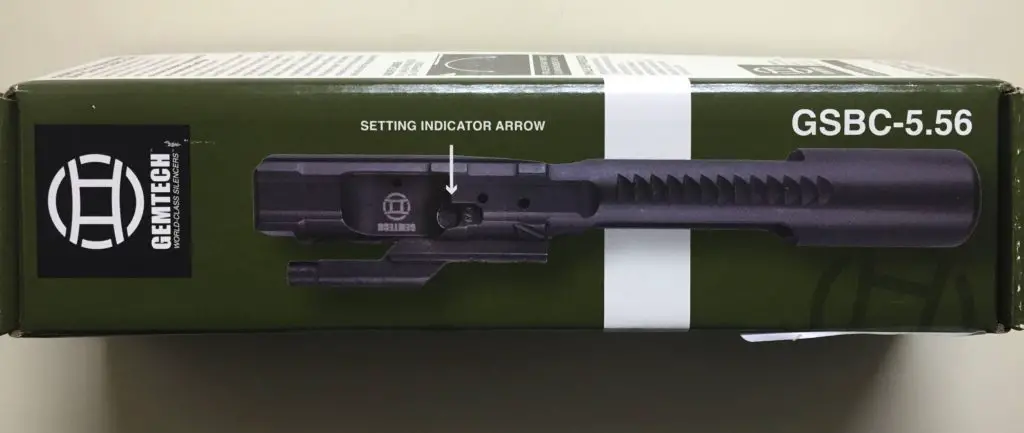 That’s pretty much it. The setting indicator arrow points aft to S, or forward away from S, and makes the whole system fairly Ranger-proof.
That’s pretty much it. The setting indicator arrow points aft to S, or forward away from S, and makes the whole system fairly Ranger-proof.
The GemTech bolt carrier is adjusted with a flathead screwdriver, but other tools will work in a pinch. The valve can get a little gummy.
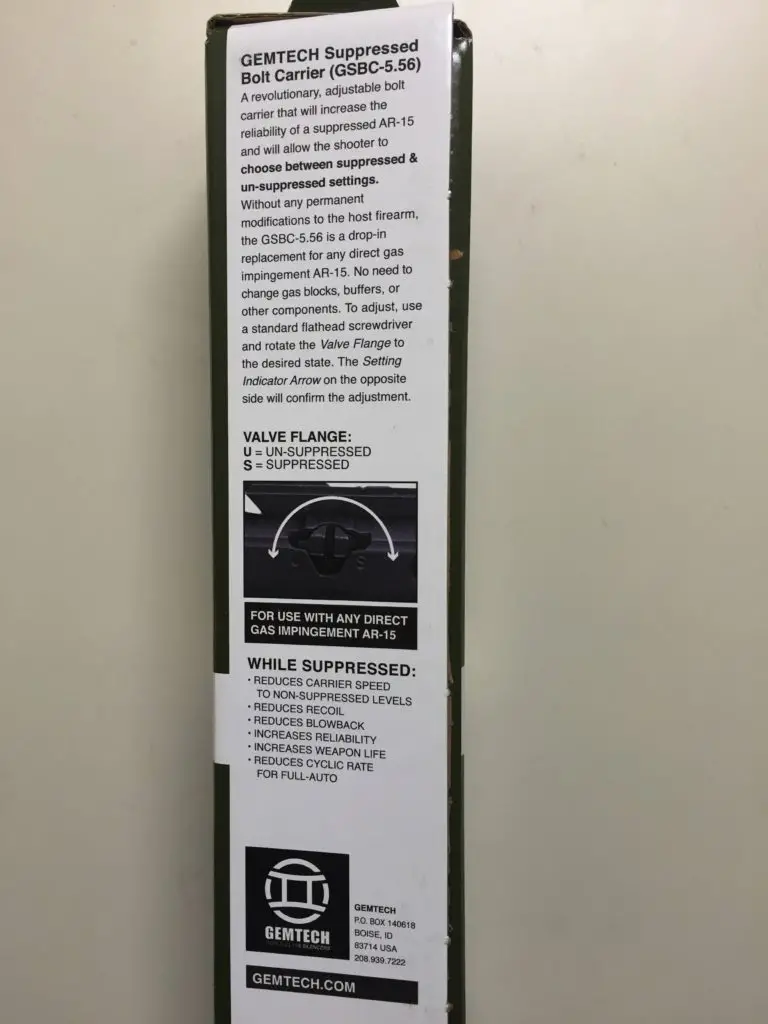 The GSBC comes with the carrier key screwed and staked in place, but otherwise it is a bare carrier. It is conventionally notched for use with a forward assist. It lists for $249 and can be bought direct from Gemtech or from Gemtech dealers.
The GSBC comes with the carrier key screwed and staked in place, but otherwise it is a bare carrier. It is conventionally notched for use with a forward assist. It lists for $249 and can be bought direct from Gemtech or from Gemtech dealers.
Here’s a close-up of the flange where the valve can be adjusted. 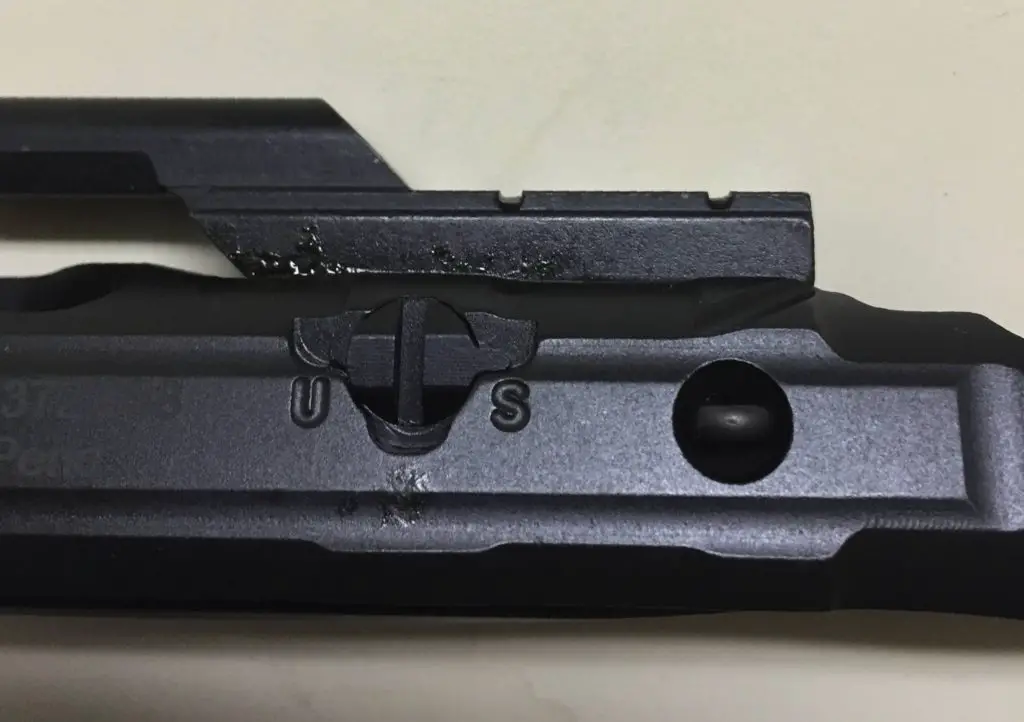
Gemtech’s claims of reduced carrier velocity and reduced cyclic rate are supported by an analysis by Philip Dater, available on the Gemtech website (.pdf). The reduction was significant on several different weapons, but much larger (25%) on an M4A1 than on a Mk 18 (16%). Still, that’s not trivial.
Coming: a 10/22 Chassis Prototyped by 3D Printing
Rifle chassis are an “in” technology right now. They allow you to trade off the lighter weight and greater comfort of a polymer or wooden stock for the flexibility, rigidity, and accessory-compatibility of the typical chassis.
In the military the chassis is a good idea because the same rifle must often be reconfigured for different shooters and missions. Civilians might not need to do that, but it’s nice to have, say, adjustable pull length and cheekpiece position for a day at the range with the whole family.
It was inevitable that someone would combine this popular accessory with the world’s second-most-popular accessory host, the Ruger 10/22 rimfire rifle. In this case, Canadian outfit Spectre Ballistics has designed, and is preparing for production, an economical and fairly light 10/22 stock. It’s not on their website yet, but they’ve shown the prototype — which was 3D Printed.
The actual stocks will be CNC billet aluminum.
There’s a pretty good discussion of the stock and its design and the manufacturing schedule on Reddit. In time, the stock will be available for pre-order on the Spectre Ballistics website (not yet!) in KeyMod and M-lok versions. Target price is $200 CAD, and, unlike American firms, Canadian accessory firms are not under ITAR pressure from their counterpart to our State Department.
 (They only have to bowdlerize their 10/22 magazines because Dudley Dimwit of the Mounties can’t tell rifles from pistols).
(They only have to bowdlerize their 10/22 magazines because Dudley Dimwit of the Mounties can’t tell rifles from pistols).
Meanwhile, Canadians, Americans, and probably anybody else who can own a 10/22 can pre-order the sock sometime around the beginning of November, if all goes as planned.
A Roundup of Glockery from KD4
Kyle Defoor has been posting some interesting Glock stuff lately, good and less good. Some of this applies to Glocks alone, but some of it can be extrapolated to other pistols and even other firearm types.
The Well Accessorized G19
Here’s an interesting rig: Aimpoint Micro T2 in a Balor mount and light on a G19 with the red-dot-ready slide. In this image it has a Streamlight TLR-1 and a stock Glock barrel, but he also runs it with a Gemtech barrel and suppressor. By the time the suppressor is on it, why a G19 and not a 17? Thing’s a horse pistol. Mind you, it’s a horse pistol set up for not-too-loud rapid work, mostly indoors. For most users, G17 and G19 is a distinction without a difference; the 19’s a bit more concealable, if you’re not going to accessorize it to near-carbine size. (If you’re in ICE, though, the 19 is forbidden fruit).
Asked about what it took to get the mount to fit with the T2, KD4 replied, “a little grinding.” Otherwise, the G19 is fairly stock, with some stippling, but few of the common modifications (no extended slide stop or mag release, for example).
Maybe Centered != Zeroed
Unlike many (most?) pistol users, he’s a big believe in sighting in the pistol, and adjusting the sights to zero the pistol, rather than just live with the factory sight installation or use a mechanical-zero method or centering, or some kind of boresighting approach. That sometimes means your “fixed” sights won’t be centered when they’re fixed appropriately. As he puts it with hashtag poetry: #notcentered #shootsstraight.
It’s all about accuracy. Any Glock or modern service pistol has more innate precision than the guys shooting it, but for that precision to be accuracy it has to shoot to point of aim. Many people think, “at pistol ranges, so what if i’m off a few inches/centimeters? Minute of bad guy is minute of bad guy.” Look at it this way: you are better off having accuracy you don’t need, than needing accuracy you don’t have.
This is especially true when you consider how combat itself will degrade your accuracy. It is much harder to shoot straight when your heart rate rises to allegro and beyond.
The Dreaded Glock “Face-Off”
Then, the bad. Kyle hadn’t seen this before, but others have, and it’s been an occasional subject on forums like pistol-training, glock forum and glock-talk. Yes, if you dry-fire a Glock a whole lot you can get some pretty weird failure modes, like the whole freaking breechface coming off.
In case you’re not up on Glock topography and immediately up on what you’re seeing, the upper half of the picture is looking aft from off the front side of the slide, and you can see a truncated-conical divot has been dry-fired clean out of the breech of the pistol. The lower half is the divot. These happen from time to time in heavily dry-fired Glock firearms, and the way to forestall them is to use dummy rounds or snap-caps for dry-firing so that the striker (or firing pin) stops in the “primer” substitute, not by slamming its shoulders into the back of the thin breech face. Snap caps have several other benefits, but Glock users should probably just get a SIRT trainer which removes the necessity to cycle the whole slide to get a trigger reset.
Glocks, like AKs, are extremely reliable and durable, which leads to a general perception that they’re indestructible. That’s not a correct perception, as they’re not (neither are AKs). They’re just more tolerant of abuse and neglect than most of their competitors, which is certainly something.
Clever, Minimalist Bipod
Now this is a clever thing, and a brilliant use of 3D Printing in combination with over-the-counter materials (in this case, carbon fiber tubes). Result: an ultralight carbon fiber and printed plastic bipod.
It’s from our dude, Guy in a Garage, and unlike some of his designs, you can build it yourself, or he’ll build one for you; you can email him at [email protected]. The files are here:
https://www.sendspace.com/file/eepzs0
And come with these words of caution:
Be warned, this is a tricky print.
And the carbon tube is here, in 1-foot or 3-foot lengths (you’ll need carbide tooling and patience to cut it):
http://www.mcmaster.com/#5287t32/=148nduc
The ridiculously light weight (1.5 ounce) comes by sacrificing some of the adjustability of the common Harris bipod, requiring the legs to be individually removed from the bipod position and placed in the storage/traveling position, and using ultralight carbon fiber for the legs. By contrast this example of a Harris “ultra-light” bipod gives you much more flexibility in how to deploy it, and is more convenient to use, but adds 13 ounces to your firearm — 867% of the weight of the carbon-and-print rig.
The ultralight weight of this bipod allows it to be positioned much closer to the muzzle with much less effect on balance. Lots of Harrises are set fairly far back, just to keep the weapon closer its design balance point.
You know, a bayonet catch would make this a perfect thing. Otherwise, we’d fear the legs would, in time, wear away at the printed plastic of the adapter.
100% Inventory Underway
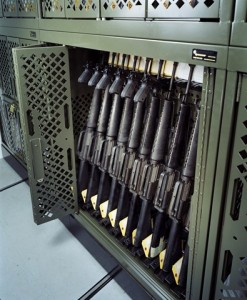 The other day, we came up short a gun for a photo shoot. Whaaa? Well, it’s past time to tidy up around here. (OTR dropped by recently, and threatened to report the Manor in general, and the office in particular, to one of those TV Hoarder shows). There’s a fine line between a collector and a hoarder, isn’t there? We’re determined to stay on the non-bat-guano-crazy side of the line and not be like the crazy cat ladies where they find mummified cat carcasses among the piles of old gun magazines and rusty toasters.
The other day, we came up short a gun for a photo shoot. Whaaa? Well, it’s past time to tidy up around here. (OTR dropped by recently, and threatened to report the Manor in general, and the office in particular, to one of those TV Hoarder shows). There’s a fine line between a collector and a hoarder, isn’t there? We’re determined to stay on the non-bat-guano-crazy side of the line and not be like the crazy cat ladies where they find mummified cat carcasses among the piles of old gun magazines and rusty toasters.
For all that we preach physical security, we’d gotten lax. The light in the main safe went out, and we didn’t fix it. (Failure one). We took guns out for photo ops and they sat around the office, library or even the kitchen for days before being returned. (Failure two). We used various non-standard bags and boxes to move guns around, and didn’t always remove the guns when they got more-or-less to destination (that’s failure three). We had more guns than practical safe storage for them (failure four) and occasionally hosted guest guns that were commingled with our own guns (failure five). We had guns that were not logged into our database (and we’re up to six, and counting).
Most of all, we were casual about putting down books or other stuff on top of guns. So we might well have a gun on a desk, then five books in three languages, then a bank statement that came in and a few press releases from manufacturers. And where was that gun again?
Now, as a private owner of firearms, you have relatively few legal regulations about how you store them, unless you live in some lawless hellhole like North Korea or Massachusetts. Manufacturers and FFLs have more regulations, and those regs can act as a guide to best practices for the private gun owner or other non-licensee who has more than one pistol and a pair of hunting guns. The ATF publishes guidance on inventory control and booking, and licensees that follow it have a lot fewer troubles with an Industry Operations Inspector’s visit that licensees that think they know it all. So the ATF way can guide you.
So can the way the military keeps track of guns. Unlike the Federal criminal investigative agencies that lose scores of guns every year, the services seldom lose a firearm outside of combat; and when they do, it’s usually not lost for very long. (Anyone remember the agency that lost an M4 and a couple of handguns — and never got the M4 back, or made a case against the thief or the criminals caught in possession? It wasn’t the military).
Here are some suggested Best Practices, and we’d welcome discussion in the comments, based mostly not on the right way or the wrong way, but the Army Way:
- Have an inventory. This seems trivial, but a shocking number of people do not. Our local police chief estimated that in only one in ten residential burglaries that had firearms taken, could the owner produce a list of the firearms by serial number for NCIC entry. This not only prevents the owner from recovering his firearm, but also prevents police from prosecuting criminals who receive the stolen firearms. Very often a stolen firearm is sold on the streets, but they may also be pawned, and ethical pawnbrokers welcome stolen firearms alerts from the cops.
- Make the inventory easy to use. The more arcane and complicated it is, the more likely it will get neglected and not be 100% complete when you need to broach the subject with the police or insurers. Simplicity is your friend: Manufacturer, importer, model, year, caliber, serial number, other significant markings and a photo are optimal, but make/model, caliber, serial will do in a pinch. (The Army uses NSN, SN, and a couple-word description, plus the line number of the item on the unit’s Modified Table of Organization & Equipment [MTOE] or Table of Distribution and Allowances [TDA]; that’s all that’s in the inventory dump).
- Have enough storage. This is commonly violated by citizen gun-owners because it’s more fun to buy guns than buy safes. What do you do with overflow? A Job Box bolted to a basement floor or wall and secured with good padlocks is a $300 solution, until you can get that $1000 safe.
- Tag in, tag out. If the gun is out, hang a tag in its place indicating who has it or where it is (the Army does this with a Weapons Card. There are many versions: here’s one as a .pdf that you can print, four to a page, duplex. In Army use they’re generally laminated).
- Limit “Withdrawals” The kind of limitations include requiring a need to remove, removing a limited number at a time per user, and a limited duration.
- Keep Storage Locked. Check it daily, a great time is when you walk your perimeter to ensure doors and windows are closed and locked before bed.
- Store Magazines and Ammo separately, but also locked. See the Job Box mentioned above.
- Maintain climate control. In our normally damp, cool basement, we do this with a room dehumidifier that keeps the basement ≤45% humidity, and a rechargable dehumidifier insider each safe. Belt and suspenders humidity management.
- Conduct frequent inspections. The reason for doing this should be self-evident: it’s to ensure that all your other control measures are working effectively. Here you’re looking for condition, primarily (rust is the secondary enemy of firearms, after national socialists) and
Looking at this list of best practices, it’s clear where we came up short. In the end, the missing vz. 24 that we wanted to A-B compare to a vz. 22 turned up — the dealer that sold it to us shipped it in a Smith & Wesson revolver box, and the whole box was still out of the safe. That was a bad turn of affairs, because it was not only out of our control, but also in an packaging irresistible to burglars.
When Your Friends Call You a Bond Villain…
…You might as well get the props you need to play the part.
Here’s the story behind these striking grips:
We never had roommates like that… they bought stuff for their own jeezly Lugers.
And here’s the tale behind the Luger:
Both from this thread in Reddit’s /r/guns. (Well, the picture is from Reddituploads, but it’s linked at the Reddit comment thread).
Ow! Defoor Disses the ACOG
When the Elcan Spectre DR came online to replace the ACOG TA01NSN, we loved it — for about 30 minutes. It was a beautiful piece of glass (at its staggering price, it should be) and the dual magnification — a flip of a lever migrates you from 1 to 4x and zero holds like a rock — was that rare thing, a marketing feature that action guys could actually use. It was bulkier than the ACOG, but had less stuff to snag on your stuff. But lots of us fell out of love with it nearly as fast. Its weak spot was that, while it was stronger than the typical sporting scope, it was no match for the ACOG’s anvil-like qualities. (Over time, of course, operators could break the early ACOGs too). Trijicon is really good about standing behind these old scopes and will go through one and update the tritium, for example, for a reasonable charge ($150 last we checked).
But that was then, and this is now. And here comes Kyle Defoor to put down our favorite (if elderly) combat optic. He writes:
Getting some time on the ACOG this week. Some dudes still use it/are issued it as their primary. My department is to show them how to use whatever they got as good as they can.
To be a professional in this biz you got to be able to show up and shoot whatever, whenever completely stock and sometimes use the gear of the customer if you don’t have what’s needed……and with that, thanks to the guys for loaning me one to rock while we trained together.
And he accompanied it with the usual entertaining array of hashtags:
#defoorproformanceshooting #acog #training #carbine #5days #runwhatyoubrung #makethebestofit
And therein lies a valid point. There’s always going to be something new and technically a bit better than last year’s (or in the case of the TA01 ACOG, decade’s) model. Chasing an optimized “best” rig is not worth the trouble for most people. First, if you are a pro user some guy way up the chain from you is probably going to dictate what you use, or if you’re lucky, dictate what options you have to choose from.
This “dictation” isn’t too restrictive in some cases, like if you’re a SEAL, PJ, SF, etc. But in some other cases, like an Army support troop or Marine rifleman, you will be told what you will be carrying and will be ordered to like it. At that point, you can whine about it, sign up for selection (where, should you succeed, you will discover that you’re still working for The Man, just at a higher level), or take Kyle’s advice and run what you brung and make the best of it.
Fortunately, the baseline weapons and optics available to grunts today are quite good stuff. The fact that they don’t have this year’s shine on ’em, or weren’t on the cover of REAL OPERATORS BUY THIS magazine last month, doesn’t matter. Real operators can operate with sticks and stones, hell, with their bare knuckles; any step up from that is gravy. And you too can shoot better and more effectively with the weapons you have now, and money and time spent on ammo and training will almost always have a return on investment far beyond what you get from money and time spent picking out and acquiring new and better gear.
If you’re going to be using a carbine over a wide range of, well, ranges and lighting conditions, etc., the ACOG is still a good choice. If your most likely employment is close up, or even indoors, then a red dot is the way to go. And in both cases, training and practice can let you extend the use of either to ranges where the other selection would have been optimum.

Kevin was a former Special Forces weapons man (MOS 18B, before the 18 series, 11B with Skill Qualification Indicator of S). His focus was on weapons: their history, effects and employment. He started WeaponsMan.com in 2011 and operated it until he passed away in 2017. His work is being preserved here at the request of his family.

